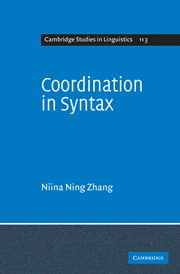Book contents
- Frontmatter
- Contents
- Acknowledgments
- Abbreviations
- 1 Introduction
- PART I NO SPECIAL SYNTACTIC CONFIGURATION
- 2 The complementation structure of coordinate complexes
- PART II NO SPECIAL SYNTACTIC CATEGORY
- PART III NO SPECIAL SYNTACTIC CONSTRAINT
- PART IV NO SPECIAL SYNTACTIC OPERATION
- 10 Conclusions
- References
- Index
2 - The complementation structure of coordinate complexes
from PART I - NO SPECIAL SYNTACTIC CONFIGURATION
Published online by Cambridge University Press: 04 August 2010
- Frontmatter
- Contents
- Acknowledgments
- Abbreviations
- 1 Introduction
- PART I NO SPECIAL SYNTACTIC CONFIGURATION
- 2 The complementation structure of coordinate complexes
- PART II NO SPECIAL SYNTACTIC CATEGORY
- PART III NO SPECIAL SYNTACTIC CONSTRAINT
- PART IV NO SPECIAL SYNTACTIC OPERATION
- 10 Conclusions
- References
- Index
Summary
Introduction
A coordinate complex is a syntactic constituent consisting of two or more units (called conjuncts), and its category is identical to that of at least one of the conjuncts. Generally, there is an element (particle, clitic, affix) to link the conjuncts. Such an element is called a coordinator, which can be further classified as a conjunctive (e.g. and), disjunctive (e.g. or), and adversative coordinator (e.g. but). How two (or more) conjuncts and a coordinator are organized in a coordinate complex has been an open question: do they form a flat multiple branching structure or any version of the basic binary-branching structure? The goal of this chapter is to answer this question.
In this chapter, I examine the structure of coordinate complexes that are composed of two conjuncts. This is the basic type of coordinate complex. I will leave my discussion of coordinate complexes that are composed of more conjuncts to Chapter 3. I will also leave discussion of the category of coordinate complexes to that chapter.
The following claims have been seen in the previous literature, but have not been generally accepted. This is why it is still necessary to argue for them in this chapter:
(A) Coordinate complexes have a binary-branching structure, and thus one conjunct is structurally closer to the coordinator than the other conjunct. This constituency is not captured by the traditional flat multiple-branching representations.
(B) The head of the structure is realized by a coordinator, and the conjunct that is structurally closer to the coordinator is the complement of the head, and the other conjunct is Spec of the head.
- Type
- Chapter
- Information
- Coordination in Syntax , pp. 9 - 40Publisher: Cambridge University PressPrint publication year: 2009

